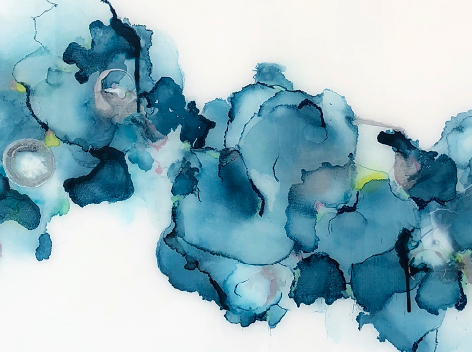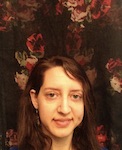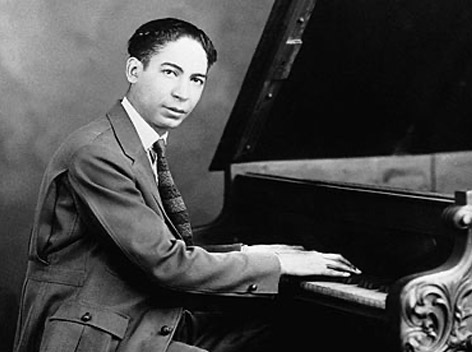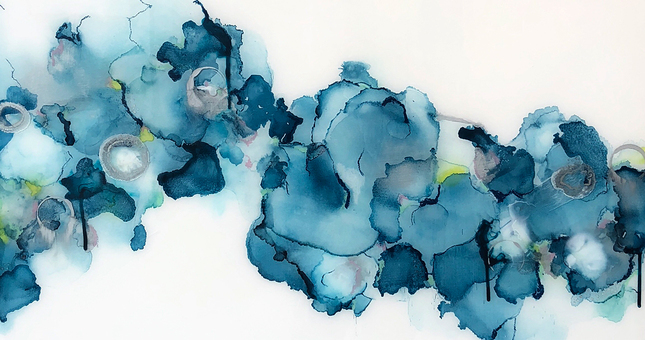
Making Womb
Bryana Russell discusses female embodiment, tacit knowledge, and the womb’s unique ability to create space for flourishing.
Last February, Bryana Russell’s Making Womb exhibition was housed in the Dal Schindell Art Gallery. Bryana is both student and staff at Regent, a wife and mother, and her life and academic interests coalesce in her interest on female embodiment. This spring, Jolene Nolte sat down to talk with Bryana about this exhibition.
JN: Today we’re discussing Making Womb, which was your IPIAT (Integrative Project in Arts & Theology) exhibition. The womb is definitely a female and hidden organ, particularly associated with pregnancy and childbirth, but in setting it up as the subject for an entire exhibition, what did you hope to bring to the fore?
BR: A common question that I feel women ask—perhaps not always aloud—is “How is my body good?” (Genesis 1:31). It is a question that arises in the face of infertility, in the face of reproductive health issues, in the face of pain, singleness, or menopause.
There are a lot of questions about how the womb, in particular, can be good. The womb has long been synonymous with ‘uterus,’ and limits the idea of the womb to being a place for childbirth and pregnancy. I wanted to explore the flipside of that.
Perhaps the womb draws attention to an ontological truth about women: that we have the capacity to make space for the flourishing of others even amidst pain, suffering, and seeming emptiness. Perhaps our practices of female embodiment create habits through which we can live in the world, bringing grace and love. Perhaps they allow us to gestate goodness and Christ himself by making space for others.
My intention for the exhibition was to explore those possibilities in a way that felt most natural to me, to leave the trappings of words aside and to create a space through art.
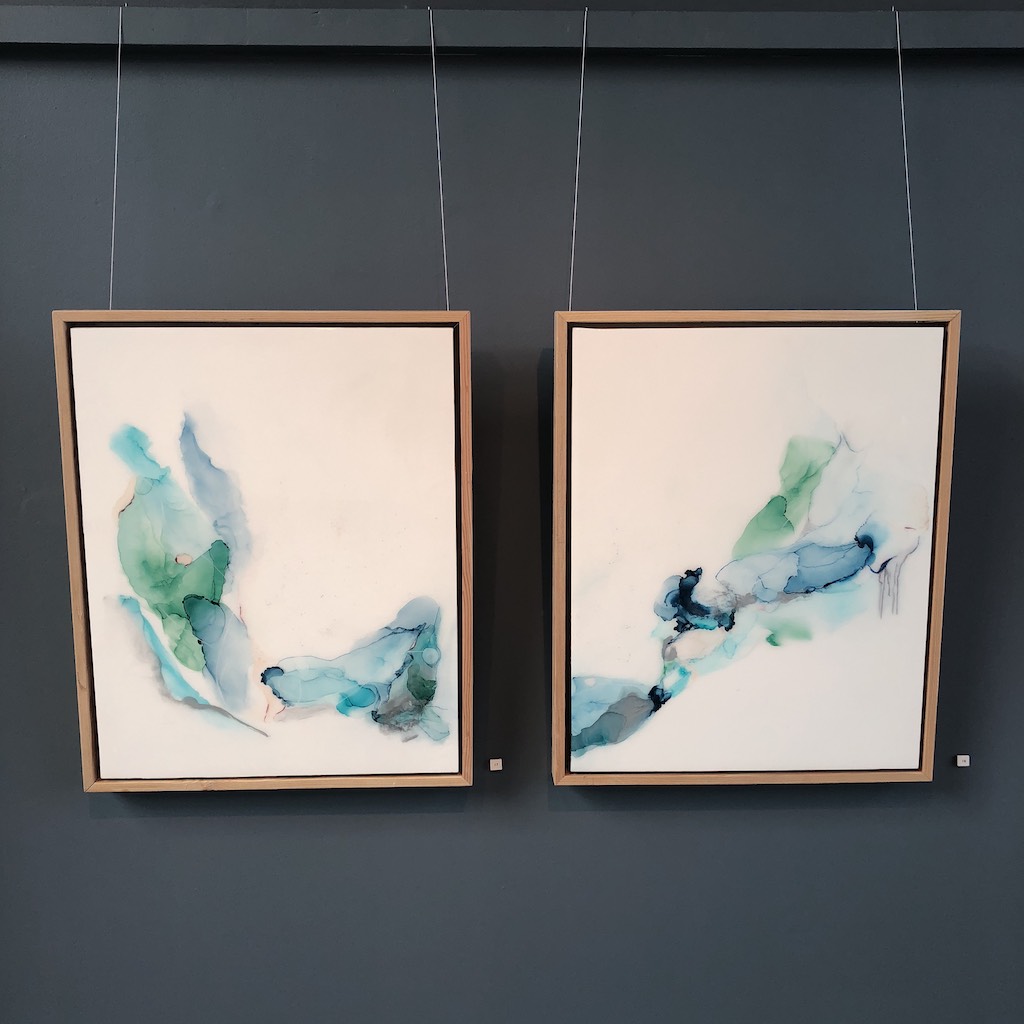
Diptych, Tel Aviv, 24"x48" Mixed Media on Birch Panel in Resin
I’m visualizing some of your paintings as we’re talking, and am wondering if those ideas about the womb inform your method of painting?
It did. I tried to work with materials that in some way symbolized the organic and chemical nature of the womb. I only worked with materials that had reactions. The ink I used, when you put alcohol in it, repels or creates movement. It always produces a chemical reaction on the canvas or the board.
Resin also requires chemical reactions. Even in the acrylic paint, you can see bubbling effects, which is part of how I used the paint to demonstrate something outside of my control as the artist. I had the materials and I put them together, with, hopefully, a vision in mind. But a lot of the beauty is found in the reactions. I worked with what they did as they reacted, reproducing as they grew together.
Is it drip painting? How does it actually work? For those of us who are not painters, could you describe your process?
I don’t know that it has a term, but in my practice I would apply ink to Yupo paper, or to the board that I had painted in some sort of primer material. I guess you could say I dripped it on there. Sometimes I used a straw—old-school childlike technique of moving your liquids—and sometimes I would just pour it on.
I would move it, most often, with my breath—with a straw or just blowing on directly on it. I would apply alcohol to create reactions and to create movement. I rarely used a paintbrush. For me that was part of the practice; trying to make it as directly connected to me as possible.
There’s an ambiguity in using your breath to move paint rather than a paintbrush. Again, there’s some control but not complete control which, I think, is true of our embodied experience as women: we have capacities, but we don’t always have control. Our bodies ebb and flow, our cycles ebb and flow, with the tides.
Speaking of ambiguity and embodiment, your subject is very concrete, your process is very physical. Why abstract paintings?
Abstract paintings can prepare a person to have what Jürgen Moltmann calls a “discontinuous moment”—a moment where heaven and earth meet, and we see the hope of the future in the present. I think it does so because the art doesn’t articulate concrete particularities; the abstraction leaves meaning to our spirit and leaves our senses to understand and to envision.
I believe abstract painting is inherently invitational because it doesn’t prescribe what the viewer is to see but invites them into an experience. In the Making Womb exhibition, I wanted to be sure to create a space where people could include their own experience, and their own ways of allowing for the flourishing of others. I think abstract art creates that space very beautifully.
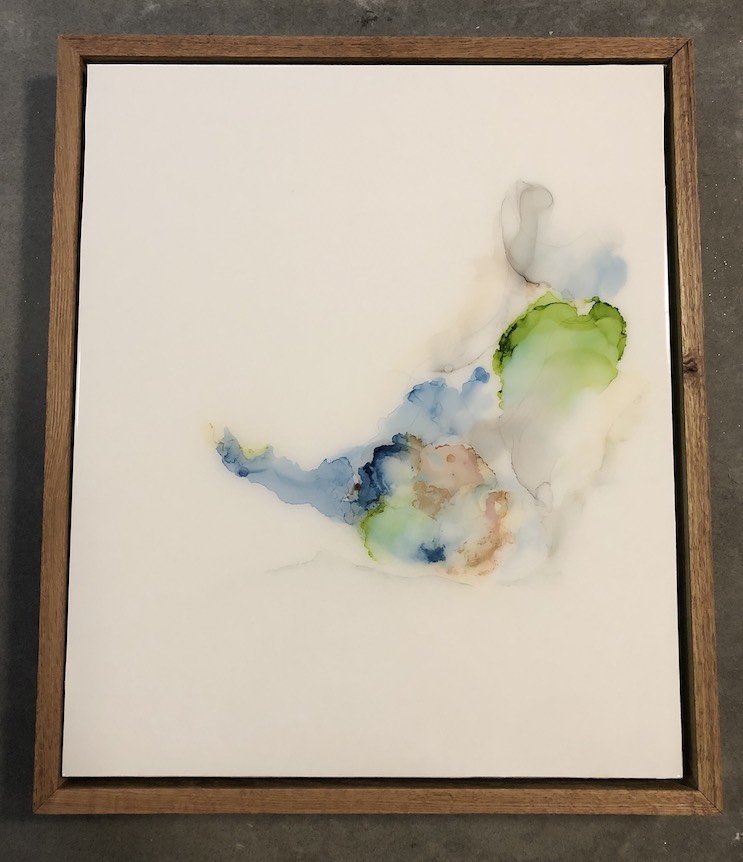
Reaching Out, 24"x36" Mixed Media on Birch Panel in Resin
What did the process of painting for this exhibition teach you?
I learned to trust that my body knew what to do even if my mind wasn’t yet on board. There’s something very intuitive about creating in this way and trusting the reaction of the paint to participate in the beauty of art. It’s a true affirmation of the material. Tacit knowledge is sometimes brushed over in discussions of theology; this process confirmed its importance.
You were reading Hildegard for this project. How did that reading affect your artwork and what you were thinking about?
In art history, female form has long been depicted by men. That extends to our imaging of the divine. Hildegard offers an alternative. She holds orthodox theology and truths, yet they are illustrated or envisioned alongside or within female forms.
For her, the circle, and shapes long associated with female embodiment play a pivotal role. She personifies the virtues as women. She gives attention to the grace and life-giving power of the womb, God’s womb. Even her vision of the cosmos is egg-shaped. She sees truth and depicts it in female form, which affirms the female body.
During the Middle Ages, there seemed to be a stronger understanding of the Feminine Divine, a more nuanced relationship to God our Mother. I wanted to read and think through such seemingly neglected theology.
Although Hildegard’s writing is couched in self-deprecating language (particularly her weakness as a woman), she truly affirms the bodily imago dei of women, and that’s what I love about her. She also suggested that her nuns drink beer instead of water. What’s not to love?
Hildegard’s thinking parallels an exploration of ‘womb-like mercy,’ which we see as one of God’s attributes in the Old Testament. In Hebrew, God’s ‘womb-like mercy’ (rachamin) comes from the root of the word ‘womb’ (rechem). The language is fascinating. Can we begin to understand that this womb-like mercy is evident in our female embodiment?
What surprised or encouraged you about responses to your exhibit?
I was blown away by the response.
In many ways this project was a case study for my hypothesis. Women demonstrated the capacity to make space for the flourishing of others, for my flourishing. (To be fair I did see that practice in men as well.) In the support that I had from Ali, who was the Arts Administrator, to Miriam Kovalishyn who was my academic supervisor, I witnessed such capacity. From Amy Stewart, who was my technical supervisor, and my friends who gathered around me and bolstered me when I felt like I couldn’t do it, I was given space to grow. My mother watched my children so that I could spend late hours painting in the studio, sustaining me still with nourishment and love.
It was a case study in how people had made space for my flourishing. It was a profound and gracious experience of being held so that I could bear fruit.
The other thing that was surprising to me at my presentation was the number of women who needed to hear that their bodies are good. And as I mentioned earlier, abstract art has the ability to speak truth in a way that it isn’t affronting. It doesn’t catch us on the defense. I was moved to see women’s eyes fill with tears as I shared that this had been an experience of understanding the body’s goodness.
Even when the body frustrates, with an empty womb, or a perceived empty womb, still it is good and it is life-giving. The deep resonance of the art and the theology surprised me the most. There was a large attendance of people from different worldviews, and still the message encouraged them. It’s motivated me to do more work on this subject—to read, think, and pray more. I don’t get back to the studio as much as I would like, but I have done two other art shows since this one. There’s much more conversation to be had about embodiment and the ontological capacity to be life-giving as female persons.
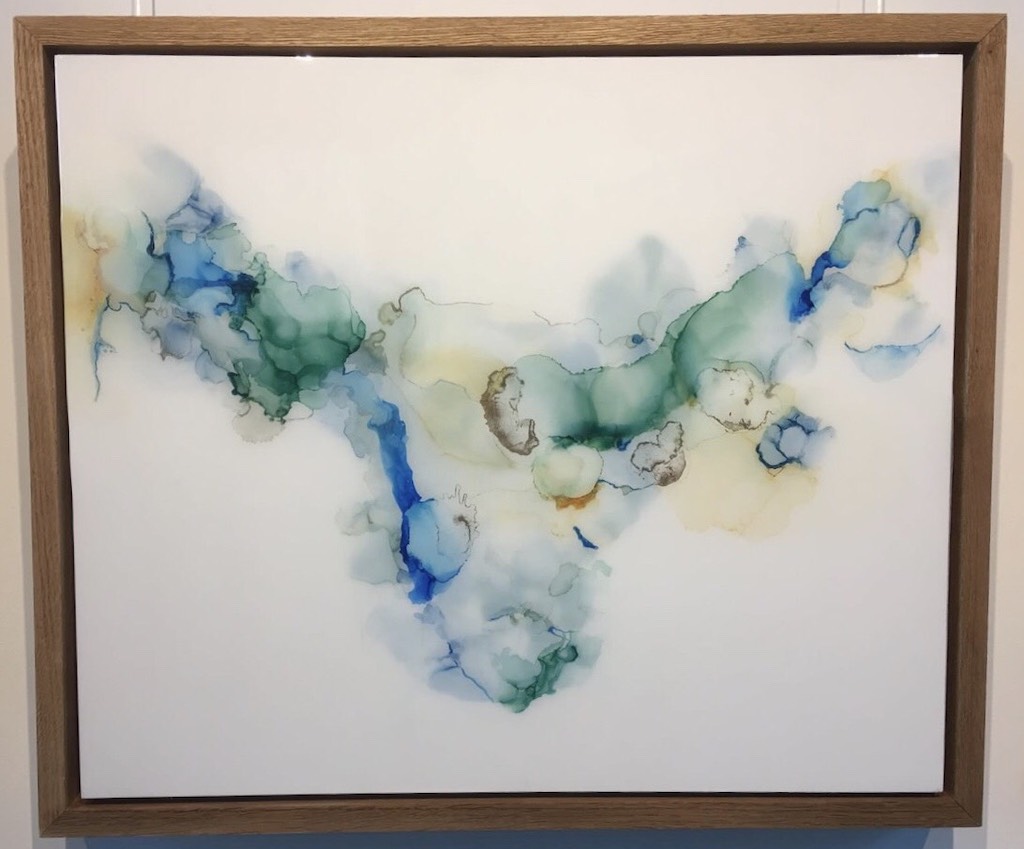
Standing Ovation, 24"x36" Mixed Media on Birch Panel in Resin
Yes, that was beautiful. I was among the people who were getting teary-eyed at the presentation.
We don’t hear it enough, and I think art’s gift is that it can begin these conversations—not to say that we leave it on the wall, but that it opens the door to have conversations about thinking that sometimes feels inaccessible.
I think Making Womb, the ontological exploration of what it means to make space for others as women, was a great opportunity to begin conversations about female embodiment. It highlighted the necessity of speaking about our bodies, of learning about our bodies, and of breaking down the divide of a filled womb versus an unfilled womb, widening where we see God’s hand.
For example, can we see the practices of menstruation as making room for life? How do we understand cycles of hope, grief and renewal that manifest in our bodies? And menopause! Who is talking about menopause? If we desire to better understand who God is, and who we are as women, we need to consider these questions. Art is always a good place to start those conversations.
Making Womb is, of course, particularly interesting to women, but it sounds like you’re commending a natural theology that is relevant to everyone’s understanding of God. Is that a fair summary?
If we only hear from those experiencing male phenomenology in theology, we risk losing the gravitas of a womb-like mercy. Ought we not hear from the woman who can authentically repeat Christ’s words, “This is my body broken and given for you” as she is torn, bleeds, and suffers to give life? Attention to natural theology, the wisdom and tacit knowledge of our bodies, speaks to God’s goodness.
Perhaps also relevant to all is the way in which we speak of such embodied things. The Old Testament’s use of the Hebrew language gives us a really great foundation to have these discussions. Words like ‘miscarriage,’ which ascribe guilt to the womb and an inability to carry life, only became utilized in the late 1970s. Prior to that, the English term for ‘miscarriage’ was ‘spontaneous abortion.’ But the Hebrew term for miscarriage is translated ‘bereavement.’ It’s a loss, a deep grief.
There’s a significant shift that occurs when we turn back to the Hebrew language and the ways in which we understood such experiences as a covenant people. It extends to how we can have these conversations now with language that is more compassionate and more inclusive.
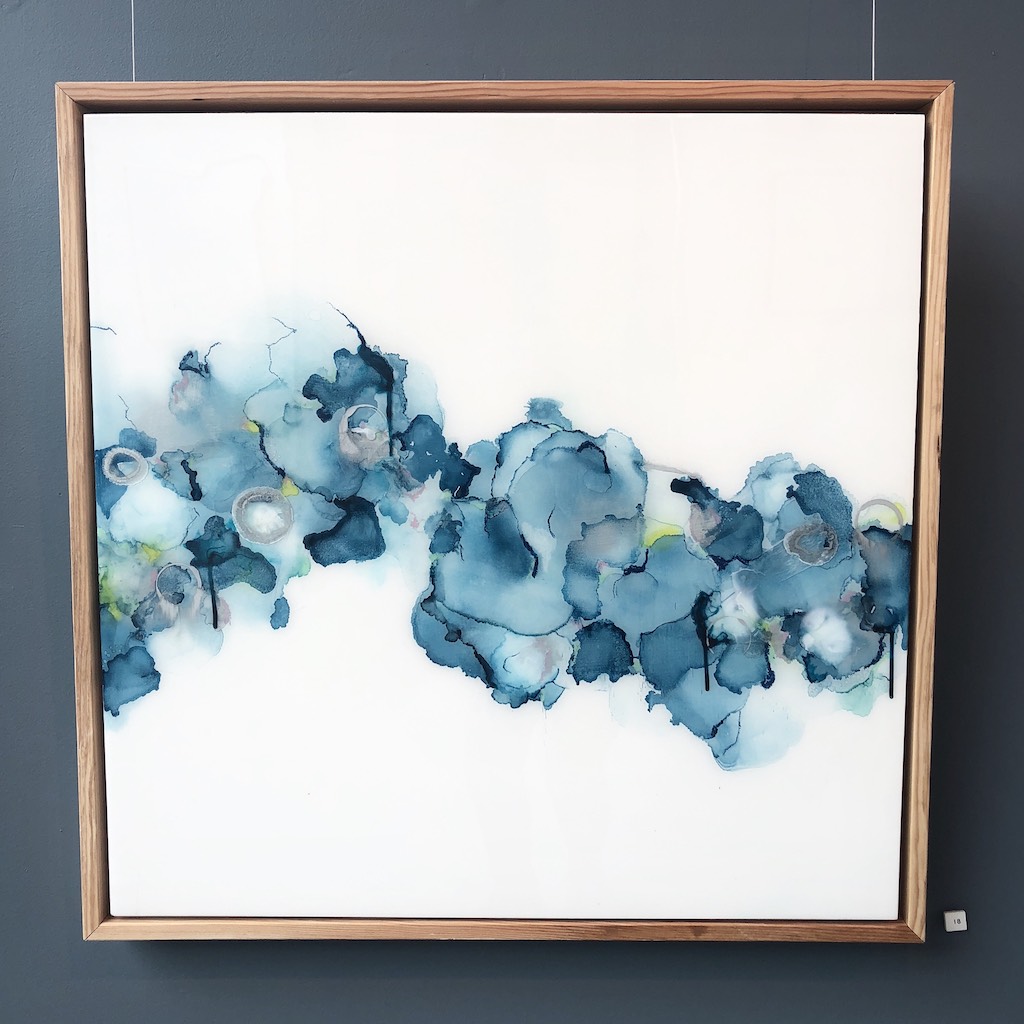
Lady Wisdom, 36"x36" Mixed Media on Birch Panel in Resin
And more physically grounded, too, it sounds like.
Yes, more embodied. With the language of bereavement and loss, we see that the female body acts as womb and tomb. To carry death and life—how great is the capacity of the body to do that.
As science develops, we learn more about the mystery of our creatureliness. Modern medicine has discovered that a mother retains some of the cellular DNA of the child that she holds within her womb. It passes through the placenta wall. Those cells then accumulate over time in places of injury in the body, helping to heal. How do you capture that in art? You probably don’t. But if you can be inspired by the mystery of chemical reactions on a canvas, how much more can we recognize the mystery, the grandeur and the miracle of chemical reactions within the body?
Isn’t that amazing? The cells go to places of injury within the mother’s body: How relevant is that to our living into the body of Christ! I think of Christ, and Mary, too, and the idea that she in her physical body had a forever connection with the divine. It was part of her embodied experience. There’s something, indeed, full of grace about that.
For another Regent World read on female embodiment—this time from a healthcare worker!—check out Sophia McLean's article, "Insights From a Physiotherapist on Living in and Not in Spite of Our Bodies."
